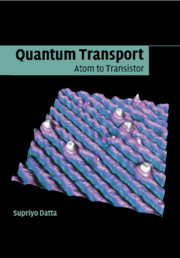Book contents
- Frontmatter
- Contents
- Preface
- Acknowledgements
- List of symbols
- 1 Prologue: an atomistic view of electrical resistance
- 2 Schrödinger equation
- 3 Self-consistent field
- 4 Basis functions
- 5 Bandstructure
- 6 Subbands
- 7 Capacitance
- 8 Level broadening
- 9 Coherent transport
- 10 Non-coherent transport
- 11 Atom to transistor
- 12 Epilogue
- Appendix: advanced formalism
- MATLAB codes used to generate text figures
- Further reading
- References
- Index
10 - Non-coherent transport
Published online by Cambridge University Press: 05 June 2012
- Frontmatter
- Contents
- Preface
- Acknowledgements
- List of symbols
- 1 Prologue: an atomistic view of electrical resistance
- 2 Schrödinger equation
- 3 Self-consistent field
- 4 Basis functions
- 5 Bandstructure
- 6 Subbands
- 7 Capacitance
- 8 Level broadening
- 9 Coherent transport
- 10 Non-coherent transport
- 11 Atom to transistor
- 12 Epilogue
- Appendix: advanced formalism
- MATLAB codes used to generate text figures
- Further reading
- References
- Index
Summary
In Chapter 9, we discussed a quantum mechanical model that describes the flow of electrons coherently through a channel. All dissipative/phase-breaking processes were assumed to be limited to the contacts where they act to keep the electrons in local equilibrium. In practice, such processes are present in the channel as well and their role becomes increasingly significant as the channel length is increased. Indeed, prior to the advent of mesoscopic physics, the role of contactswas assumed to be minor and quantum transport theory was essentially focused on the effect of such processes. By contrast, we have taken a “bottom-up” view of the subject and now that we understand how to model a small coherent device, we are ready to discuss dissipative/phase-breaking processes.
Phase-breaking processes arise from the interaction of one electron with the surrounding bath of photons, phonons, and other electrons. Compared to the coherent processes that we have discussed so far, the essential difference is that phase-breaking processes involve a change in the “surroundings.” In coherent interactions, the background is rigid and the electron interacts elastically with it, somewhat like a ping pong ball bouncing off a truck. The motion of the truck is insignificant. In reality, the background is not quite as rigid as a truck and is set in “motion” by the passage of an electron and this excitation of the background is described in terms of phonons, photons, etc.
- Type
- Chapter
- Information
- Quantum TransportAtom to Transistor, pp. 252 - 284Publisher: Cambridge University PressPrint publication year: 2005

